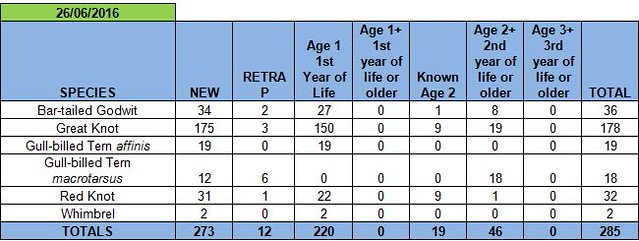Written by Patrick Walters,
Bachelor of Natural Resources & Education
La Trobe University, Bendigo
Edited by Chris Hassell
La Trobe University, Broome Bird Observatory staff and experienced volunteers rallied out the front of the main office of the BBO where Chris Hassell, Global flyway Network Ornithologist, met us for the great shorebird cannon-netting briefing. We were to be netting wild shorebirds to band them in order to continue to build on the huge dataset accumulated by AWSG and GFN. The hope is to continue to deliver sound, long term science that can influence government policy and greater conservation. Chris’s delivery was short, sharp and military in his instructions and made it clear there was no time for civilities. We were to be putting the shorebirds under some degree of stress so it was of utmost importance we were agile and deft in carrying out Chris’s instructions. If Chris said jump you jumped! This attitude at first caught me a little off guard as the typical conservation tone is saccharine and passive. Having said that Chris’s style did give me confidence in his experience and expertise.
We were lead down a narrow goat track and were ushered into a small nook of sheltered vegetation just beyond the fore-dune. There we were told to wait quietly and hidden as the final adjustments were being made for the count-down of the cannon firing. We could peek out and see through the vegetation in certain spots and see a couple of hundred shorebirds wading and fraternising on the shore. Apparently there were volunteers on opposing beaches ‘twinkling’ other shorebirds onto our immediate beach in order to increase the catch size. Time soon passed and the heat intensified; we would from time hear a murmur on the radio and sit up straight but it would be just a signal to wait on, raptors overhead. The timing had to be right, the suspense was building. Finally after a few false starts we hear over the walkie-talkies “Positions on the ready”, we all tensed up, this felt like a para-military operation.
3… 2… 1… ‘FA-DHOONK!’
The cannons exploded an almighty boom and all hell broke loose as everyone scrambled through the fore-dune onto the beach where we formed a powerful cavalry charge. Twitchers were falling left right and centre, hats went flying, thongs busted plugs but none of that mattered as the cacophony of trapped birds got louder and the urgency to get them out of the net and in to the pre-set, shaded cages was imminent.
Chris went into action barking orders while everyone surrounded the net and employed their instructions. It was at first a little distressing to see all the birds in the net, especially as some were scrambled over by other birds. However the whole situation, actually capturing wild shorebirds with a cannon net was so surreal I didn’t seem to care so much for the birds discomfort as I was overcome by the intense atmosphere.
The shorebirds were quickly handled into boxes respective to their species and then taken to the long open air shade-hut. Under the hut the shorebirds were taken out of their boxes and had their biometric data recorded, banded and set free as quickly as it was possible.
Species captured were:

? Global Flyway Network
Considering we recorded a total of 285 birds the ‘processing’ took some time but it was impressive to watch the confidence and adept skill at which the BBO Staff and volunteers handled and examined the birds, especially some of the more aggressive terns who had a penchant for the webbing between one’s thumb and index finger! The retrapped terns were 6+, 10+, 14+ (x2) and 15+ (x2). The ages in the table relate to our aging of birds in the hand.
The shore birds we tagged were not in fact preparing to embark on their great migration as they’d missed the departure date, late March/early April. These waders were in fact still juvenile 1-2 years and still maturing. The benefit of aging the birds at the juvenile stage means they can be accurately aged if they are captured in the coming years. Although it is more likely that the bird’s ages will be ‘recorded’ by resightings of them and their individual engraved flags or colour-band combinations. Red and Great Knots and Bar tailed Godwits had a tiny blood sample taken for DNA sexing and health studies.
As we recorded the birds under the huts Adrian Boyle Ornithologist explained to me the plight of the shorebirds habitat loss and subsequently their numbers were in decline. The reclamation of the Yellow Sea is seeing valuable mud flats being destroyed for urban development in China and South Korea. Previous research from counting and cannon-netting at the BBO and around Australia has seen the status of the shorebirds recently reclassified in legislative protection in Australia. Eastern Curlew, Curlew Sandpiper, Bar-tailed Godwit (menzbieri) and Great Knot are now classified as critically endangered. The key struggle however is to see cooperation for conservation on an international scale.
The day was incredibly demanding but gave the students a valuable insight into the citizen science that is required for shorebird conservation. The setup of the cannon-netting and research wouldn’t be possible without the selfless passion of the BBO volunteers.
Original report: http://globalflywaynetwork.com.au/2016-06-26-catching-report/




